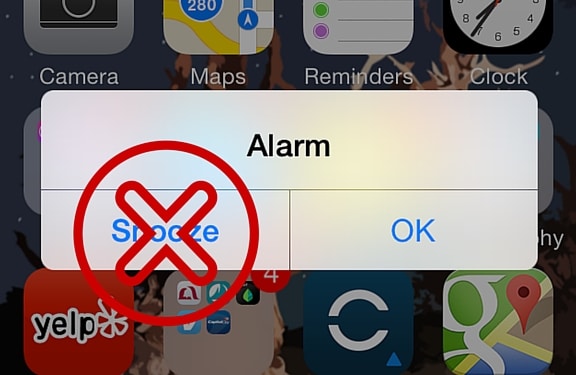
14 Easy Wake Up Tips For Early Morning Workouts
By Cory Bruno
Waking up for an early morning workout before work can be difficult any time of year, and particularly during the fall and winter when mornings are crisp to downright cold. But for some athletes, the early morning is a golden opportunity to work out so you can maintain greater training consistency and stop missing sessions. Fortunately, there are some effective and easy wake up tips you can use at any time of year to make waking up early much easier.
Keep in mind, while some of these tips may help immediately, making these habits stick means changing your habits and creating a routine you can stick with. Use these 14 tips to help you form new habits that will ease the struggle to wake up, and you’ll rise more refreshed and motivated for your morning workouts!
1. Cut Back on the Afternoon Caffeine

The most popular drug in the world could be negatively affecting your sleep, making it difficult to wake up early the next morning. Caffeine taken as much as six hours before bedtime has been shown to reduce sleep time significantly. So when you go to indulge in your afternoon coffee, make sure you still have plenty of hours left before bedtime if you plan on getting a good night’s sleep.
2. Skip the Nighttime Booze

Alcohol may help you fall asleep quicker, but you pay a price through reduced sleep quality. Alcohol disrupts your REM sleep, which is the more mentally restorative sleep, and disruptions can lead to grogginess in the morning. Not a great way to start out for an early morning workout.
3. Reduce Your Exposure to Light Before Bed
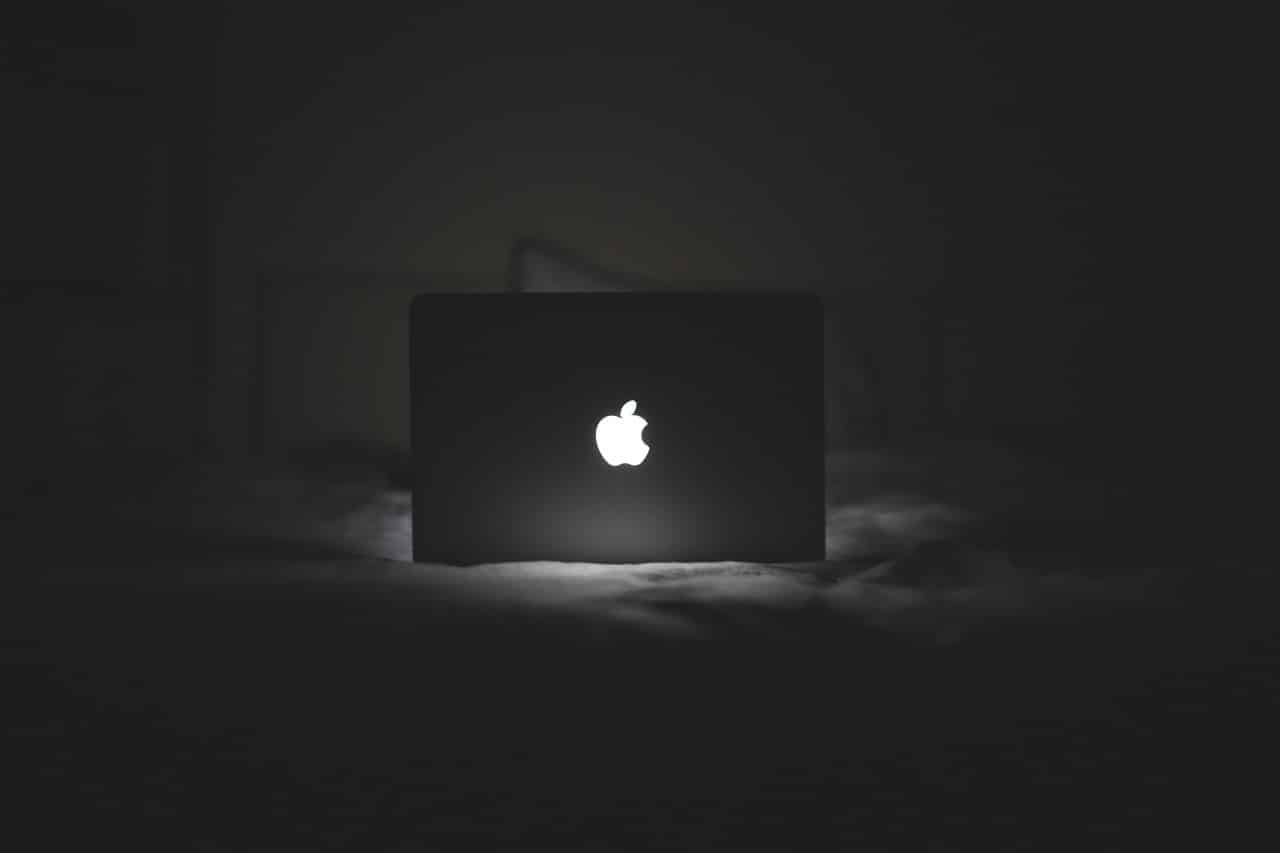
Exposure to light and the light from your electronics inhibits the release of melatonin, a hormone that helps induce sleep. The American Medical Association made the following recommendation:
“Recognize that exposure to excessive light at night, including extended use of various electronic media, can disrupt sleep or exacerbate sleep disorders, especially in children and adolescents. This effect can be minimized by using dim red lighting in the nighttime bedroom environment.”
If you just can’t put the phone, tablet, or laptop down before bed, you can try out f.lux software, which will automatically dim and adjust the color of your screen depending on the time of day, to help reduce the negative impact of light before bedtime.
4. Set Your Workout Clothes Out the Night Before
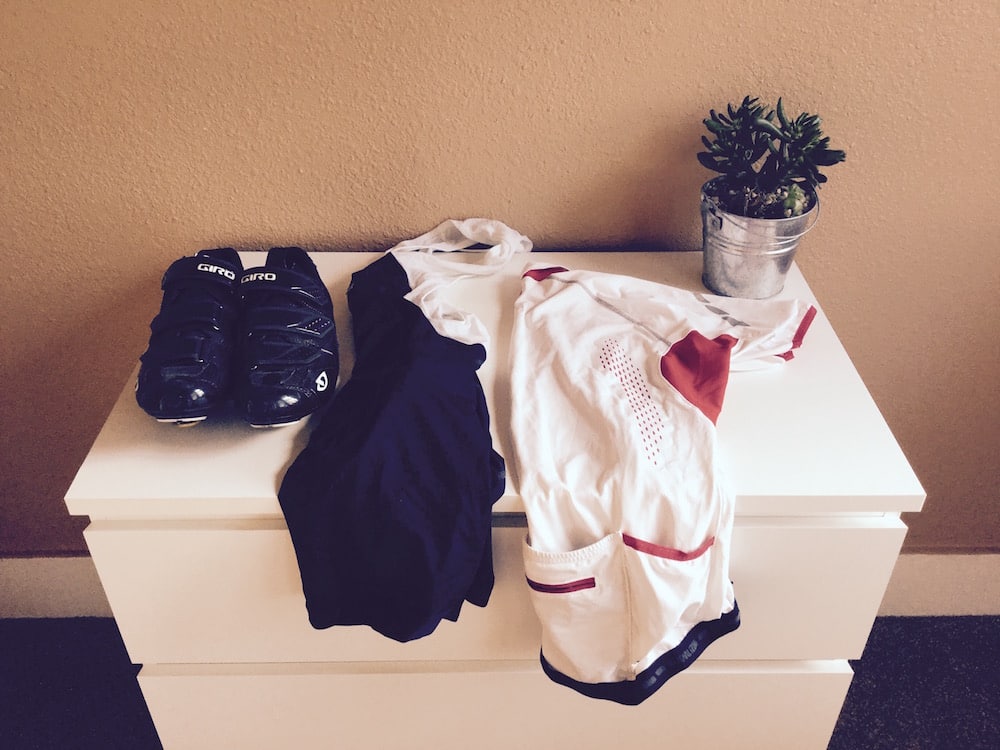
While setting your clothes out might not seem like it will help much, taking away any small barrier between you getting out of bed and out to your workout can actually make a big difference early in the morning when everything feels more difficult. Plus, you’ll save yourself a couple minutes so you don’t have to wake up quite as early.
5. Go to Bed a Little Earlier
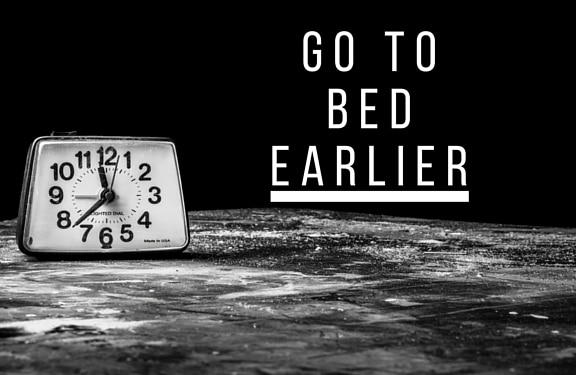
Many of us may say we fall asleep at 10 pm but in reality that’s just the time we get the process started, meaning we may not be asleep for another 30 minutes or more. Make a small adjustment and start your bedtime routine just 10 or 20 minutes earlier and you’ll buy yourself a little more sleep. Your goal should be at least 7-8 hours of sleep. Athletes on high workload training plans may benefit from even more sleep, up to about 10 hours/night.
6. Make Your Bedroom the Optimal Sleeping Temperature

The temperature of your sleeping space can significantly affect the quality of your sleep, because your circadian rhythm is influenced by body temperature. Studies have suggested the ideal sleeping temperature is somewhere in between 65 and 72 degrees Fahrenheit, but you should test to see what temperature works best for you.
7. Make Plans to Work Out With a Friend

Accountability is a strong influencer (it’s one of the greatest benefits of having a coach, and one of the top three leading reasons people sign up for coaching). If you’ve made plans to work out with a friend you will be much more likely to wake up in the morning and be motivated to stick with your training plan. Adding a third person to your training team is even better, because one training partner might bail, but both probably won’t.
8. Set a Consistent Wake Up Time
► Free Cycling Training Assessment Quiz
Take our free 2-minute quiz to discover how effective your training is and get recommendations for how you can improve.
A consistent wake up time and routine is more important than a consistent bed time for establishing a healthy sleep pattern. Even if you had to stay up a bit later than you planned the night before, still wake up at your established wake up time. If you need extra rest during the day, consider taking a nap. And if you know you will have a shorter night of sleep in the near future, try to bank sleep in the days beforehand rather than trying to catch up on sleep afterward.
9. Put Your Alarm Across the Room
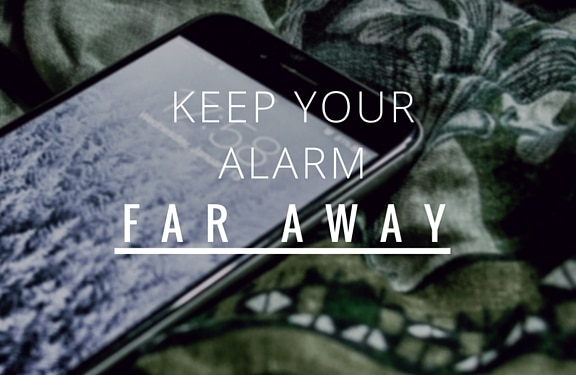
This is a simple trick to make yourself get up out of bed and move around which will help you shake any sleepiness. Once you’re vertical and out of the warm covers, you’re far more likely to just stay up and get moving. Just don’t hit snooze and jump back in bed!
10. Turn the Lights on Once You Get Up to Turn the Alarm Off

Once you get up to turn off your alarm flip the lights on immediately. For the same reason you want to avoid light before bedtime, you want to expose yourself to light in the morning to wake up.
11. Even Better, Pull Back the Shades and Expose Yourself to Natural Light

Humans have been rising with the sunrise for millennia. Even if you’re not getting up at dawn, exposure to light plays a role in lowering melatonin levels and raising cortisol in the morning, helping you feel more alert and awake. Many athletes associate increased cortisol as a negative result of training stress, and typically want to reduce cortisol levels as a means of post-exercise recovery. But cortisol levels naturally rise and fall (they peak in the morning) throughout the day in correlation with circadian rhythm. Some theorize that the morning spike in cortisol could be an anticipatory response to the coming day.
12. Do Not Hit Snooze!

When you hit snooze you’re setting yourself up for failure and likely a very groggy morning. When you lay back down and fall asleep you’re just prolonging a period of non-productive sleep. The best, more restorative sleep was REM sleep, but it is unlikely you’ll gain significant REM sleep time during a snooze interval (about 10 minutes on most alarm clocks). When you hit snooze, you’re not getting that much more rest and you’re cutting into your limited time in the morning.
13. If You Can’t Resist Hitting Snooze, Set Multiple Alarms
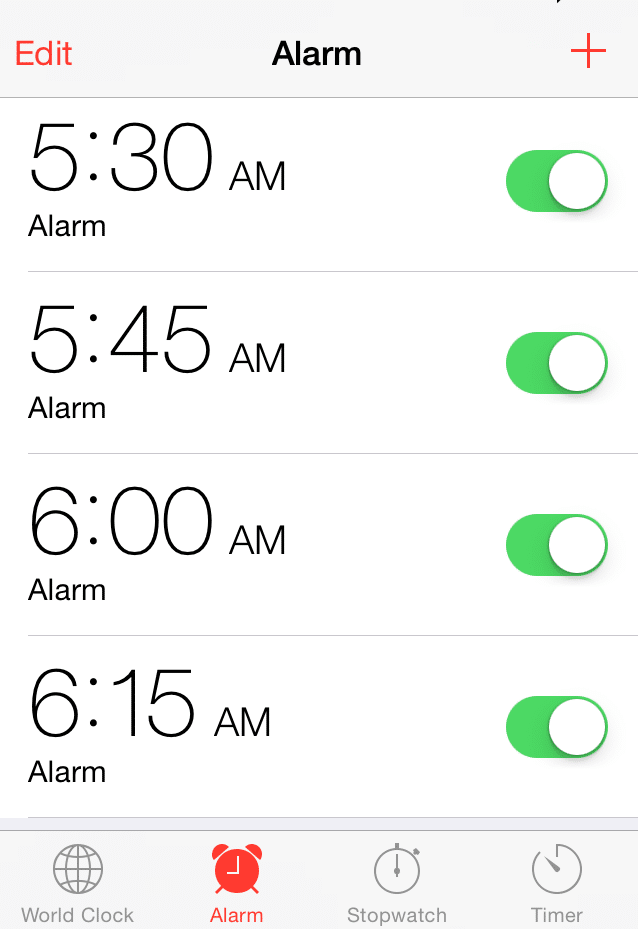
If you know you can’t help but hit the snooze button in the morning, set multiple alarms in short succession so you won’t go more than a few minutes without being woken up again. Make yourself a pest, to yourself.
14. Change Your Behavior
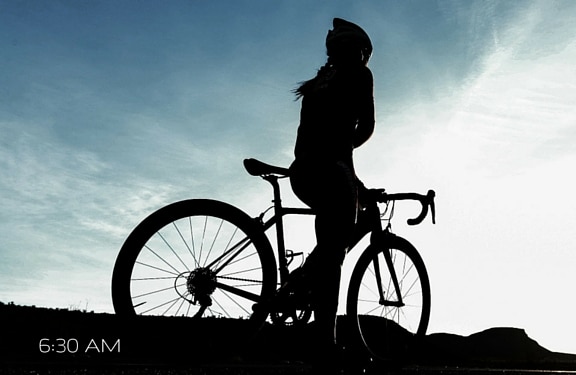
Implementing all these small changes is about building good sleep habits that may eventually lead to not even needing an alarm to wake up in the mornings. Dialing in your sleep routine will change your behavior and have you waking up more refreshed and motivated to tackle your early morning workouts.
Related Articles
3 Ways to Maximize Your Workouts With Limited Training Time
5 Tips to Finding The Perfect Time of Day To Train
7 Tips For Making Up For Lost Training Time
► FREE Mini-Course: Learn How to Maximize Your Limited Training Time
Learn step-by-step how to overcome limited training time and get faster. Walk away with a personalized plan to increase your performance.

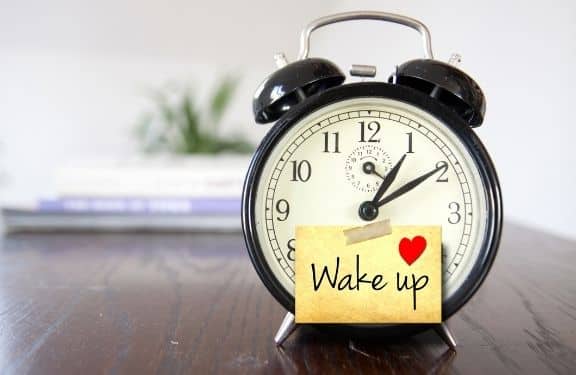
Comments 28
Pingback: Why Early Morning Workouts Might Be Best for Your Health – Freshyeh
Great daily habit for me to begin the day with an accomplishment: make the bed right away. Task done and on to the next achievement.
Right so I have lots of alarms to wake my partner up, throw back the curtains to let in the dark , 50/50 chance see it’s raining – then remember I’m retired I’ll go out this afternoon
Nice ideas used some of them when cycling to work, Now find it very difficult to get up for cx race or tt but hey I’ve paid my entrance- a great motivation
It’s waking up early if you pull back the shades and it’s light outside.
Pingback: Fitting Exercise into Your Christmas Break - Danny Williams PT
Oh how I wish I could sleep til 5:30! My wakeup is 3:45 on a normal day and 3:15 to get in a longer ride. What really gets me out the door on time is the need to make it to the train on time. Nothing like time-trailing to make it! It is hard to get up but I never regret it once on the road. I ride 30 to 60 min in the am and pm to and from the train, and another 20 min each way on the far end to get to work. That’s a good 100 to 125 miles on the weekdays I would not get any other way.
one word: C-O-F-F-E-E
I find having a big drink of water before you go to bed means when you wake up on the alarm your body switches back on and you then have to get up to go to the loo.. works every time!!
For older folks, that just gets us up two hours after going to bed
The across-the-room alarm clock idea is nice in theory, but for those who don’t want to wake the spouse or small children, a little trick I have found that works well is putting your phone on the underside of your pillow in between your pillowcase and pillow.
The pillow acts as a natural amplifier, but muffles the sound that could otherwise be heard from people in other rooms. And it’s somewhat difficult to mute as the phone is beneath you and within your pillowcase.
OMG, I thing the 5G could be damaging right underneath your head. We should all probably be sleeping with our phones in the next room. Not that I do but…
One other key consideration is hydration. If you have slept 6 – 8 hours, you likely are dehydrated and it is key before starting a workout in the morning to be hydrated. I train exclusively in the early morning (starting <6 AM). I have occasional tachycardia when pushing myself and my cardiologist suggested that lack of hydration could be a contributor.
Couple more for those of you giving this a shot for the first time:
1) Get your head in the game: it is hard work adjusting physiologically to morning training. Tell yourself this in advance, and make appropriate plans, so the less pleasant aspects don’t give you more reasons to quit down the road. Prepare to be tired in the afternoon, plan the early bedtime with family, etc.
2) Schedule a power nap for the afternoon. Your body will get used to the routine after a couple of weeks and you won’t feel sleep deprived. And if you do fall behind, schedule a longer sleep for your rest days.
Early AM is the absolute best time for me to get in my workouts. Sure it’s dark, but the advances in lights and reflective clothing is amazing. Depending upon your workouts, you can use a pretty short stretch of SAFE road for power intervals, etc. All the tips above are great. Flipping on the lights is a little tough (maybe even hazardous to your health) when you have a significant other though. Biggest challenge I found was when our kids were very young…seemed like someone was ALWAYS up in the middle of the night….which made it that much tougher to spring up in the AM. Keep at it though!
Waking up is easy. The issue is that there is no light before 7h30 in february. Forget about December and January.
Second thing is that ridung for less than 1h30 is not satisfying. Start at 7h30 + 1H30 riding + 15mins breakfast + 15 mins taking a shower + 20 mins to reach work. Being at 9h50 at office is a little bit late. But ok, I will give it a try.
Indoor Trainers don’t need sunlight 🙂
I get up at 5am, have a bowl of cereal, get my bottles ready, catch up on e-mails or w/e and get on the bike around 6-6:15ish, get my “training” in, off the bike around 8am, ride 9mi into the office before 9am.
If you absolutely hate trainers, there are plenty of really bright lights you can purchase in store or online.
Zwift is a big benefit for early morning riding…when it is dark and bleak.
Almost to level 25 on Zwift and your intervals look perfect on Training Peaks if you use ERG mode. I personally skip the ERG if my interval set involves over threshold work because I need more “wiggle” room. It’s almost always dark, cold or really wet during these workouts
Pingback: 5 Bike Fit Tips That'll Improve Your Comfort and Power - CTS
I’ve been on the “early morning train” for over ten years. I find the best strategy is to treat the early morning workout like a JOB. There are so many reasons NOT to get up. When it’s your JOB to get up you have more drive and dedication to putting the work in. I am a parent with limited time. The ONLY time I have is between 4 – 7 AM. It’s great to knock out a 30 mile ride before anyone wakes up. Any parent out there can relate to not having time at lunch or after work to workout.
The most important point in all this is … change of mindset to make all these points “a way of life.” When the alarm rings just get up and get going without thinking about it. Has worked for me for years. When I have paused to consider getting out of bed, it has been the times I usually turn over and lie in – or go out and don’t enjoy my ride ?
Check out my App “Gentle Wakeup” at https://play.google.com/store/apps/details?id=com.changemystyle.gentlewakeup
In the past I had problems waking up in the morning as well. Then I tried out a wakeup light and was really impressed how refreshed I felt when the light waked me up gently.
That is why I developed the app “Gentle Wakeup”. It gives you complete control over length and intensity of the sunrise simulation. That is very important because everyone has a different sensitivity for light.
And best of all: It’s completely free!
Don’t hit the snooze? It’s like the last vestige of my slovenly life. 🙂
#10 is nice for summer, but what do you do when your alarm goes off before there’s any natural light outside?
Greg – I’d never get up in the winter without a “sunlight” alarm clock. It’s an alarm clock that has a light that get lighter over a span of 5-30 minutes before you wake up (usually you can set the interval). They go upwards of about $100. Worth their weight in gold.
I also got a sunrise alarm clock recently. I thought it would probably be an expensive gimmick, but I was pleasantly surprised. It actually does help me wake up so I’m more clear-headed and energetic in the early morning. I ride my indoor trainer this time of year with bright LED flood lights in the garage. And lastly I do my easy zone 1/2 rides in the early morning, and reserve the hard interval rides for days I can ride in the the early evening.
Also with No. 4: Pump up your tires, fill your bottle and put it on the bike, reset your GPS, put your food in your pocket etc. Do everything now so you won’t have to do it before you set out.
Really. If you wake up and put reasons up not to get out and ride then you really arent in love with cycling. if so why bother @ all